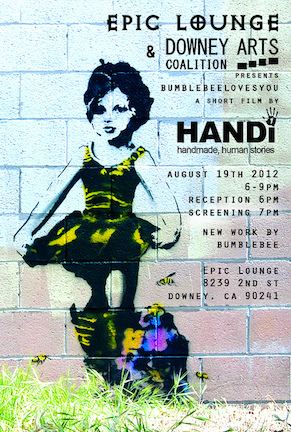Since 2002 (updated often), your old-school website for all things stencils. Photo, video, links, and exhibit info submissions always welcome. Enjoy and stay curious.
Donate any amount to support this DIY site.
Buy Stencil Nation or take a tour
Our best photos on Instagram and flickr.
29 Aug: 10am Mural Premiere (SF, CA)
Please join me (Russell) and Chris Benfield at our new mural tomorrow morning from around 10am until noon. The indoor mural is located at 1150 Ocean Ave. (at Lee Ave.). You can take public transportation to get there: MUNI: 43, 49, KT ... BART: Balboa Park Station (walk up hill towards Phelan)

The 1,800 square foot mural includes around 100 hand cut stencils, and depicts a pre-European San Francisco peninsula full of animals, plants and insects. Beginning with an eastern scene over the San Francisco Bay, the mural stretches down the corridor, passing Twin Peaks, Lake Merced, oak groves, and the Sand Dunes and wildflowers of the mural's location, and into the Pacific.
Chris and Russell will have sprayed stencils on bristol paper for sale at tomorrow morning's premiere. All proceeds will go to the Center for Biological Diversity, an organization that tirelessly protects endangered plants and animals in the USA.
There will also be an evening premiere at the mural, held in early September.
8 Sep: Rone's Darkest Before the Dawn (SF, CA)

http://whitewallssf.com/events/
Rone’s posters are some of the most iconic in Australia, hiding under overpasses throughout Melbourne. He is renowned for the stylized images of girls’ faces - it wouldn’t be a stretch to say that he has had more posters in Melbourne’s streets than any other artist in the city’s history. Rone is one of the original members of Everfresh Studios where he still works daily. His ‘girls’ come with him as he travels and now appear on the streets of Los Angeles, New York, London, Toyko, Barcelona and Hong Kong. Of all the stencil artists from the initial Melbourne stencil boom of the early 2000s, he is the only one remaining who still is consistently getting his work up.
Rone’s art has been acquisitioned by the National Gallery of Australia, and in 2011 he sold out his first ever solo show in Melbourne before it even opened, highlighting his status as the literal poster boy of Australia’s next crop of street artists.
Fall from Grace was his first solo show of 2012, coming on the back of an invitation to Hawaii’s Pow Wow convention of contemporary street artists in February and the joint Don’t Look Back exhibition with Brit Tom French at London’s Zero Cool Gallery in April.
19 Aug: BumblebeeLovesYou Short Film (Downy, CA)

Carmichael Gallery
Bumblebeelovesyou
A film by HANDi
With new work by Bumblebee
Epic Lounge
8239 2nd Street
Downey, CA 90241
Reception: Sunday, August 19, 2012, 6pm (Screening wil commence at 7pm.)
Carmichael Gallery is pleased to announce a special screening of the new documentary short Bumblebeelovesyou, a visual profile of Los Angeles-based artist Bumblebee. Presented by The Downey Arts Coalition, Bumblebeelovesyou was produced by HANDi, a team of Downey-based filmmakers.
There will be a reception and screening at the Epic Lounge in Downey on Sunday, August 19, 2012, followed by a discussion on the documentary and the growing art scene in Downey. A series of new works by Bumblebee will also be on view.
9 Aug: Urban Ibiza

FEATURING ARTWORKS FROM:
GOLDIE - BANKSY -
DAVID WALKER - INKIE -
CHRIS BRACEY - FIN DAC
K-GUY - MAU MAU -
SCHOONY - REMI ROUGHE -
BEN ALLEN - PINO
PURE EVIL - COPYRIGHT
CALM & COLLECTED
LILLIWEN - KID ACNE -
KASHINK - WILL BARRAS -
RYCA - BEN SLOW
CHU - STEFF - PLAETZ -
ZEUS - MYSTERIOUS AL -
... and more: http://www.urbaninibiza.com/urbaninibiza4/
CRASS: Existencil Press Update
PUBLICATIONS
Anyway, at last CRASS ART AND OTHER PRE POSTMODERNIST MONSTERS by GEE VAUCHER has been published and is now available. Calverts have done another great printing job, though it’s pretty weighty to post, (but then it’s not a lightweight book), but we hope you think it is worth ordering.
----------------------------------------------------------------------------------------------
FUTURE PROJECTS
There are quite a few new books in the pipeline that we hope to have published by the end of the year.
First we are aiming to have a new book by autumn from
PENNY RIMBAUD - 3rd STREET BLOCKADE - Miles in the Corridor
A poem of wide, wise and confronting beauty inspired by a recent visit to NYC.
Get Crafty: Stenciled Wallpaper for Movie Sets
Working Hollywood: Tony Roche
The designer finds wallpaper design fascinating, and he's created a special one for 'X-Men: First Class.'
June 12, 2011|By Cristy Lytal, Special to the Los Angeles Times
For some, staring at wallpaper is as much fun as watching paint dry, but not for designer Tony Roche, who created a handmade silver leaf wallpaper on display in the 1960s-set mutant superhero saga "X-Men: First Class."
"I have to say, sometimes when you mention to people wallpaper, they glaze over slightly," he said. "It's a bit like saying you're interested in spotting trains. But it surprises me how beautiful wallpaper is, when a lot of people think of it as being rather domestic and boring. It's often seen as one of the lesser arts, but there's some great skill and creativity within it."
"Most kids used to cover their schoolbooks in brown paper, but because my dad was in the decorating business, I used to cover mine with wallpaper," he said. "And I actually think that was an influence on me in a strange way. I quite liked the mathematics of pattern and repeat. And also the precision appealed to me — the fact that it could be loose but precise."
Article continues here.
Sean Murdock
Is a Nationally known mixed-media artist, street artist and photographer based in the Bay Area of California half of the year and Miami Florida for the winter art season.

